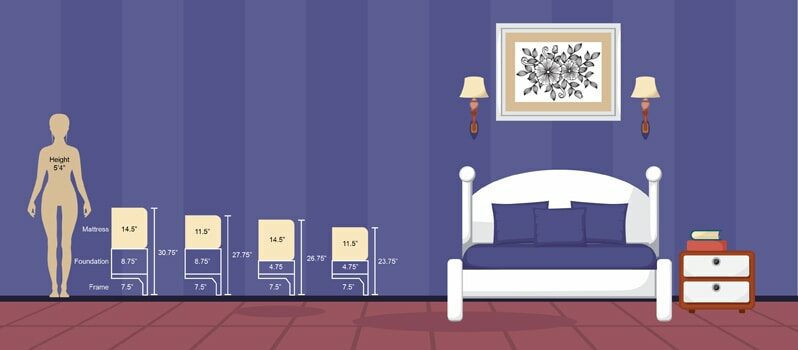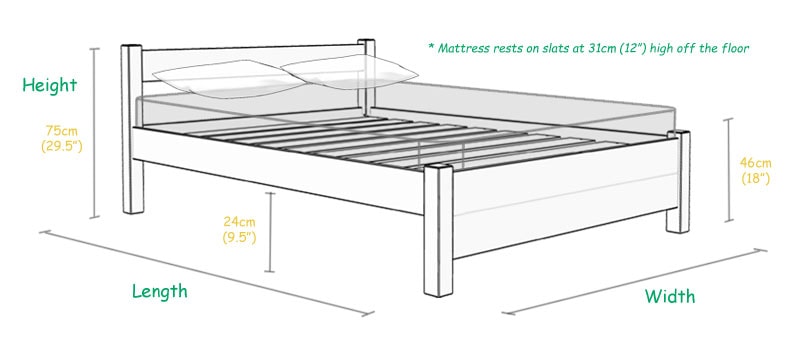Standard Bed Height: The Standard Bed and Mattress Height from the Floor

What is the standard bed height, if there is such a thing? What should be the standard height of a bed and mattress from the floor? Some mattresses are fairly thin, while others can be a foot thick! So is there any standard, or can they be any height depending on the platform/frame and thickness of the mattress?
It makes sense for beds to be of a standard height – or at least manufactured to some form of standard. When you sit on the edge of your bed it would seem sensible that your feet should touch the floor. Today’s bed heights range from around 18″ to 24″ off the floor – some a little higher. The average bed height is close to 24″ but there are so many variations in modern beds and mattresses that there is practically no such thing as a standard bed height!

Neither is there such thing as the average mattress height or even a target height as there would be with a sofa or dining chair. We shall be discussing below the health issues involved with a bed height of various dimensions. We will also look at the difference between bed or mattress height and mattress thickness and how each may be important in its own way.
The height of your bed may have little to with aesthetics or health issues. The average bed height of a futon is determined by its ability to be rolled up. There is no such thing as a recommended average mattress height, although a standard bed height could be recommended for older people or for those with specific orthopedic conditions.
So is there a need for a standard mattress height? Let’s have a look at the pros and cons of specifying a recommended average bed height. Here are the three major factors that affect the optimum bed height for most people: A) Health Reasons, B) Age and Mobility and C) Aesthetics. Let’s discuss each of these in turn.
The height of your bed is not important for sleep purposes. It makes little difference if you are sleeping on a 10-inch mattress at floor level or on a solid wood base 24 inches off the floor. However, if you have issues with your back, your spine or your legs then the height of your bed may be important – in fact, it is likely to be crucial to your continuing good health.
Though many people don’t generally consider it, you can place significant stress on your leg and back muscles getting into and out of your bed. This is particularly the case if your bed is too high or too low for you.
Optimum Bed Height at Knee Level: You can put significant strain on your body if you try to stand with the base of your spine way below your knees when sitting. The average person’s knees are between 16″ and 22″ off the ground – give or take an inch or two. It is far easier to stand up from a sitting position when your knees are at the same level as the base of your spine.
If you are sitting too low on your bed, then the strain on your thigh and lower back muscles can be considerable. Yet many people like low beds. They believe that if the bed height is low, then it seems cool and modern. Not only that, but a low bed can make their room look larger. They fail to appreciate the potential health issues involved with standing upright from a bed not far off floor level.
Children: There are two age extremes: young and old. A child’s bed is generally better to be low than high. Some kids roll off their bed at night, and many people believe that a child’s average bed height should be lower than that for an adult. They have a less vertical distance to fall. This also makes the bed easier for a child to climb on to.
However, your kids might fight for the right to a bunk bed! If so, then that is a good alternative to a lower bed – assuming that the children are well protected with guard rails. So, for children: either bunk beds with good guard rails or lower-level bed heights. Let them have their say in the bed height they want and you will have fewer complaints if they don’t like it when it comes (“Well you chose it!”)
Elderly: The bed height for old people should be such that they can easily slide into their bed and also easily stand up from it. Too low a bed can make it difficult for them to stand up without help. Elderly people dislike being helped to get out of bed – or into it. They feel they are losing their independence.
They are likely to struggle and harm themselves before admitting the need help to get into, or out of, their bed. Too high a bed gives rise to the risk of injury if they roll and fall off the bed. They also have to climb up onto a higher mattress.
Solution: Get elderly relatives involved in the decision. Let them try lower and higher beds and mattress heights. Take them to the store if possible and give them the options. Then there will be no come-back on you if they dislike the bed! That may be true, but the main reason for doing this is to allow them to feel involved, and not being steam-rollered into a bed they may not like.
Probably the worst reason for choosing a bed – “because it suits our décor and room style!” You would be surprised (or perhaps not) at how often we hear this! Forget the needs of the person using the bed! Ignore the fact that it may even be an impractical sleeping surface!
You have a themed bedroom so your bed must suit the theme. A bedroom furnished in the Victorian style may be fitted with a huge, high bed that you need a degree in mountaineering to get up to. A Native American style might be a blanket on the carpet, over a thin futon- style mattress. You may even sleep on a futon – a genuine futon that can be rolled up or folded in two for storage during the day.
Aesthetics have a very small part to play in your choice of bed size – or should have! Style and heritage have a very small part to play when your health is involved. If you can sit on the bed with the part of your legs from hips to knees extending out straight, then the bed height is good for you. If not, then you need to change until it is.
There is no meaningful relationship between your bed height and mattress thickness. You may have a high 18-inch foundation and a thin 6-inch mattress, or a 12-inch thick mattress and a 12-inch high slatted base. Both form a 24-inch high bed.
The latter example would likely provide the more comfortable sleeping surface due to the thicker mattress offering more comfort. This is where bed height cannot be equated with comfort. Mattress thickness tends to relate to the comfort of the sleeping surface. Bed height relates to how easy or difficult it is to get into bed and to stand up once your sleeping time is over – refer to our Section B above.

There are many questions regarding the standard bed height or standard mattress height. The most commonalty asked the question is
No – there is no specified standard mattress height or even an average bed height to which manufacturers must conform. The foundation (whether box spring, metal framed spring unit, solid wood or slatted) has no standard thickness and neither does the mattress or any mattress topper that is used.
There is no ‘best’ because everybody is different. A fit and healthy 70 year old may find a bunk bed or a 6-inch futon equally comfortable. Another of the same age may be unable to stand up from the futon or climb up onto the bunk bed. So no, we cannot categorize the elderly as we do bed heights.
The bed height is irrelevant to gastric reflux – it the angle of the bed that matters. You can help reduce your discomfort while in bed by raising the top of the mattress. Place bricks or some other solid items beneath the top feet of your bed. The top of the bed will then be elevated, preventing any reflux passing up your oesophagus into your throat and mouth.
But no – your bed height is irrelevant. It is the angle up from your stomach to the top of your throat that matters. You can also bulk up the pillow and your shoulders with extra pillow or bolsters.
You are not alone! Generally, the oldest should sleep on top – or the most sensible. Make sure you have guard rails fitted that they cannot remove – they are sure to try! They should be OK, but I would lay an old mattress or mattress topper on the floor by the side of the bed to make a softer landing if they try to play Superman!
The average mattress height refers to the height that mattresses usually reach from the floor. The bed height can generally be equated with the mattress height. There is no standard bed height or standard mattress height as such. The average mattress or bed height, as stated earlier, is around 24″ – 25″ from the floor. That enables most people to sit on the bed and swing their legs up onto it.
If there is an average or standard bed height, it should be around 24 – 25 inches from the floor. The term ‘mattress height’ is the same – the height from the floor to the mattress top. The optimum bed height for any individual depends on their height and lower leg length. Ideally, your upper legs (thighs) should sit horizontally when you are sitting still.
Sit on your bed with both feet on the floor. If your thighs slope downwards, or your feet struggle to sit flat on the floor, then your bed is too high. If your knees are higher than your thighs, then your bed or mattress is too low. This may not be a serious issue for younger people, but it may be for pensioners and those with leg or lower back pain.
Richard has been working in the mattress and bedding sales sector for many years, and he believes that he knows just about all there is to know to help you choose the best possible mattress for your needs. He has been featured on sites like Realtor, Mom.com, etc.
Medical Disclaimer: By using the insidebedroom.com website and/or purchasing any products or services through this website, you are voluntarily agreeing to this Disclaimer. You are agreeing that you have read, understand, and consent to the terms herein.
The information and other content found on this website, or in any linked references, are not intended to be expert medical advice and should not be construed as such. No information on this site, including written text, images, graphics and any other form of information, is intended to be a substitute for professional medical advice, treatment or diagnosis, but is intended for informational purposes only. If you need any form of medical advice or information, then refer to your physician or other medical expert.
Darris says
Good day! My mom is 5’5, 73 of age with a mattress that sits 31 inches from the floor to the top of the mattress. Is that too high for her? And if so what should the height be?
Mahiuddin Suman says
Hello Richard, I thought I’ll write an article about the standard measurement of a bed and its detailed classification. but got your post. Now I think you made my job easier! Thank you so much!
Richard Morse says
Glad to hear that 🙂
Richard Morse says
A bit high, Ideal would be around 25 inches.
JILL says
I am 5’2. Is a 28 inch bed height too high? My leg inseam is that number (:
Anna says
I never realized that the standard bed height varied depending on the type of bed and mattress. This post has been super helpful in deciding on the right bed for my new bedroom setup, thanks for sharing your knowledge!